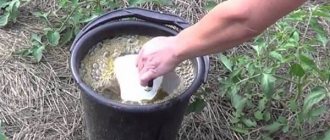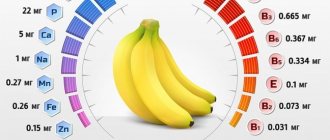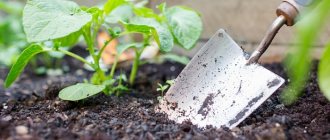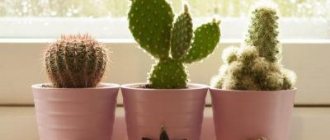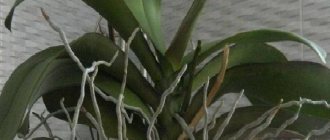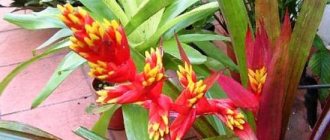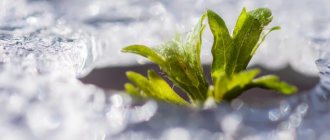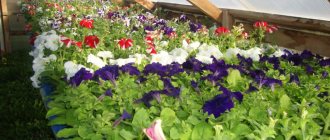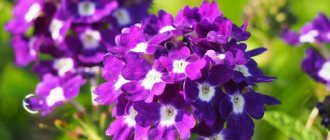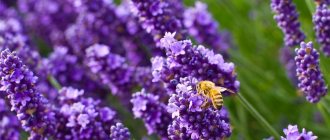Choosing a pot for a novice gardener can be a real headache. After all, there are so many of them in the store that your eyes just run wild. But you can’t rush into a purchase: your indoor plant should grow not only in the most beautiful pot, but also in the one most suitable for it.
Hello, friends! Today's post is dedicated to those who love and grow flowers at home. From time to time, plants require replanting, and this is where the question often arises for an inexperienced gardener: which plant should choose which pot?
In the store, my eyes widen: this pot is cute, and this one, and that one... After all, I want to buy pots that are not only beautiful, but also suitable in size for plants. How not to get confused in the huge assortment and choose the right pot for your green friend: so that both the flower is comfortable and the owners’ eyes are happy?
Let's figure it out. And let's start with the fact that there may be several criteria for choosing a new “place of residence” for your flower:
- pot size;
- the material from which it is made;
- form;
- color and texture.
Which of these criteria do you think is the most important based on plant preferences? I think you have guessed for yourself that the first thing you should pay attention to when choosing a pot in a store is its size.
My blog about indoor plants on Yandex Zen: come in, there’s a lot of interesting stuff there!
How to choose the right flower pot?
So, you bought a houseplant or the plants simply grew bigger and became cramped in the old pot; you need to replant them. Especially purchased indoor flowers are often sold in containers for transportation, transplanted into a new pot
simply necessary.
Flower pot sizes
Let's decide on the size of the flower pot. If the plants are tall and mature with massive leaves, they will need a large pot (for example, monstera, ficus, clerodendrum).
Plants such as violets, gloxinia, pelargonium and the like are better suited to small flower pots
.
Pay attention to the diameter and height of the pot. The height of the flower pot should be at least 1/3 of the height
the plant itself.
The diameter of the pot is selected as follows: the wider the crown of the plant, the wider the diameter of the flower pot. For plants with a height of 30 cm or more, a pot with a diameter of 20 cm or more is suitable. The ideal proportions of a pot are obtained when the diameter is equal to 2/3 of its height
.
When choosing a pot for very tall plants
, such as common myrtle, pay attention to the diameter of the base, it should be at least 1/3 of the height of the plant.
Return to contents
Types of pots for indoor plants, differences
In order for a houseplant not only to please the eye, but also to fit organically into the interior, you should choose the right container. Even the most exotic and beautiful flower in an unsightly and old pot will lose its charm. At the moment there is no shortage of choice. However, it is worth understanding what types of pots for indoor plants exist and how they differ, and whether it is worth overpaying.
Plastic pots
The most common and cheapest are plastic pots. Now manufacturers produce a wide variety of colors and shapes. Plastic pots can be seen in any store or market.
The advantages of such pots include their low cost, light weight and durability. It is wise to place such pots on shelves, walls and other surfaces that are dangerous to overload. If dropped from a height, the pot will remain unharmed.
It is worth noting that such pots look cheap and are very difficult to fit into the interior.
Clay pots
Clay pots have always been highly valued. This is a natural material that is well accepted by plants. Even a clay pot coated with ordinary varnish looks very pleasing to the eye. And if you choose one painted with various glazes, then such a pot can become the pride of any living room.
The disadvantages include their high cost and small range.
Ceramics
This is the most popular material for making pots nowadays. It looks much richer than plastic and has more variety than clay pots. Nowadays, you can find ceramic pots in all sizes, shapes, colors and patterns. The plant feels good in such containers.
This pot is quite heavy, making it difficult to place. Modern ceramic flowerpots are quite durable and some can even survive a hit to the ground.
Glass
Vases made of translucent glass look sophisticated and elegant. The cracked glass style pots are especially distinctive. Their main advantage is translucency, thanks to which you can see the roots of the plant. Most often they are used for orchids.
The biggest disadvantage of such pots is their high cost and fragility.
Natural materials
Pots made of wicker, wood, bamboo and even textile are also widespread. They won't fit in every living room. They can also be called impractical. They are usually used in the form of flowerpots or hidden inside a transparent plastic container.
The main criterion for choosing one of the above-described types of pots for indoor plants should be high quality. Cheap plastic cracks over time, and low-quality paint on ceramics swells and peels.
However, if you choose a temporary pot, then it is better to choose a plastic option and not overpay.
In the long term, it is better to spend money and buy a good ceramic or glass pot that will delight you and highlight the unique style of your interior.
Flower pots – what material to choose from?
Plants feel especially comfortable in clay and ceramic pots.
. One of the disadvantages of such a pot is fragility. It may break if dropped, you need to be careful. When reusing such pots, they must be disinfected.
For larger plants that sit on the floor, buy a plastic pot.
, it is much lighter than ceramic and it will be easier to move the plant.
The most practical and relatively cheap plastic pots
. Today there is a huge selection of plastic flower pots in stores.
Return to contents
Video – Flower pots
Our recommendations for a beginning florist.
If you are still afraid of making the wrong choice and have not fully understood how to choose a pot for an indoor flower. We decided to give universal advice that will allow you to avoid many care mistakes in the future. Use regular, cheapest plastic pots. They are sometimes called seedlings (or “for seedlings”). Indoor flowers are also sold in such pots in stores. They have many advantages. Large drainage holes allow excess water to drain during watering and significantly improve the air supply to the roots. They have a universal shape, that is, they are not high, not low, not narrow or wide. Such proportions allow the substrate to dry out more evenly, which means it will be “more difficult” for you to fill the flower. In such a pot you can successfully grow plants with both a superficial root system and those with deep roots. In addition, they are lightweight and easy to work with. When choosing a size, follow the paragraph “General rules for choosing a pot.” And for aesthetics, insert the pot into a beautiful flowerpot. By the way, in this way it is easy to solve the problem of a new interior design. Tired of the old design, just replace it with another flowerpot. Note that using this option does not even require a transplant. This means you will avoid unnecessary injury to the roots.
Subscribe to our channel on Telegram
Choosing the right flower pot
If you are going to replant and divide the plant bush, you will need several small pots.
When transplanting adult plants, choose a pot 1.5-2 cm larger
than the old pot. When replanting plants, a new soil mixture is partially added.
When replanting a young plant that continues to grow, you will need a pot 3 cm larger than the previous one.
When replanting fast-growing or large plants, and when the next replanting occurs in 2-3 years, select a pot 4 cm larger than the old one
.
If you have old flower pots in stock and want to use them, they must be disinfected and then dried. Chlorine-containing products are suitable for disinfection.
Return to contents
Regulating plant growth by pot size.
With the help of pots you can partially regulate the growth of plants. It is known that in larger containers the green part develops more intensively. Of course, subject to the necessary care. Accordingly, if you want to curb growth, you need to give preference to smaller diameters. The same applies to beautiful flowering plants. They grow foliage more intensively in larger pots. Therefore, it is also advisable to use small diameters for flowering. But for plants that are usually kept for the sake of beautiful leaves, you can take a larger pot than recommended to speed up growth. Of course, within reasonable limits. The most common way to regulate growth using small pots (along with other methods) is in the Bonsai technique.
A small pot is one of the techniques for inhibiting growth
Are drainage holes in flower pots necessary or not?
Flower pots for growing plants must have drainage holes
to drain excess water.
But there are pots that serve as decorative ones - flowerpots without drainage holes. The main disadvantage of pots is the accumulation of excess water at the bottom after watering, which leads to rotting of the roots and the development of various diseases.
If you purchased a pot without a hole, you can use a drill to carefully drill it. There should be one hole in the pot for every 10 cm2 of volume.
Plastic or ceramics, which pot to choose?
There are many pots on the market made in different styles and from different materials. Today we will look at flowerpots made of plastic and ceramics and determine which material is better for indoor flowers.
Plastic pot
The material appeared relatively recently, in the twentieth century. Products made from this material have gained leading positions among gardeners. They are distinguished by reasonable price, lightness and variety of shapes.
Some designers have developed fashionable plastic pots with an unusual pattern that are illuminated from the inside. They especially highlight the beauty of flowers.
Minuses. It is worth remembering that cheap plastic is toxic and can harm the flower. Also, this material does not breathe, does not allow moisture to pass through, and is quite fragile. Drainage is often placed at the bottom of such pots to prevent water from stagnating in the roots.
Ceramic pot
One of the oldest materials used by mankind. Products made from this raw material are considered classics. They cost more, but the demand for them is no less than for plastic. Among the advantages of the products, environmental friendliness stands out.
Minuses. Ceramic pots are covered with glaze. They look fashionable, but their walls do not allow air and moisture to pass through. Therefore, for many cultures such flowerpots can only be decorations. You also need to consider the risk of purchasing low-quality counterfeits.
Which pot is right for you - decide for yourself. The main thing is to weigh the pros and cons. It is better to opt for more expensive material. Remember that the future of the plant, its health and growth depend on the choice of flowerpot material.
When thinking about how to choose a flower pot, you need to be guided first of all by important rules. Typically, they consist of promoting optimal plant development.
Remember, when buying pots, they must have a drainage hole, smooth walls without grooves or depressions.
Be sure to buy a pallet in the form of a disk or with low sides. The volume and shape of the pot is an individual matter and is selected separately for a specific plant, depending on the size of its roots.
Pots - how to use?
Such pots perform a decorative function. Flowerpots are made from various materials: ceramics, plastic, wood.
Often flower pots with plants are placed in flowerpots. Flowerpots give an interesting aesthetic appearance to the interior, but excess water must be drained every time after watering.
You can put moss between the walls of the flowerpot and pot, which will absorb excess water after watering, gradually evaporating the moisture. If you will be using a flowerpot
, as a way to increase humidity, you need to choose a size 3-4 cm wider than the pot that will stand inside.
Return to contents
Focus on the roots
The main reason many varieties need larger pots is hidden below the ground rather than above it. Although different types of plants may have different preferences regarding pot size and the space required for root development, most grow best when the pot is at least 4-5 cm larger in diameter than the plant itself.
In this case, the roots will be most naturally distributed in the soil and will be able to receive water and nutrients from the entire volume of soil.
Pots - types and choice
Classic flowerpots in pastel or neutral colors can highlight the beauty of plants.
Bright flowerpots will push the beauty of plants into the background, attracting with their original appearance.
Plain flowerpots
They will bring a certain style to your home, but sometimes, a strict selection of pots of the same color becomes monotonous and boring.
Many people like to decorate flowerpots with their own hands using various materials (pebbles, shells, beads) and needlework techniques.
Return to contents
Subtleties of measurement
To correctly determine the size of a pot, you first need to figure out how to measure it correctly. There are different shapes of planters and they are all measured differently.
Lenten dessert without flour: semolina pie turns out so good you'll lick your fingers
A three-meter crocodile was caught from a residential area in Florida (video)
Prayer to be read at home on Parents' Saturday, March 27
For example, the size of a round pot is determined by the diameter of its top. However, there is a catch: although the pots may have an identical diameter, this does not necessarily mean that they are the same size. Therefore, it is also worth comparing different containers based on the volume of soil that can fit in them.
Features of planting and growing aloe
Aloe belongs to the genus of succulents. This perennial plant comes from the dry regions of Africa. It is grown as an ornamental foliage and medicinal pot crop.
Caring for a flower is limited to creating the conditions under which it grows in the wild. Features of the growth of an inhabitant of the hottest corners of the earth:
- The lighting is intense; in winter, additional lighting may be required.
- The temperature is room temperature, in winter about +10…+14 °C.
- Watering: during the growing season after the top layer of soil has dried, in winter two days after the substrate gets rid of moisture.
- Fertilizing is useful mineral and nitrogen-containing, carried out in spring and summer with a frequency of 1 time per month. After transplantation, the plant does not need fertilizer for six months, since all the necessary nutrients are in the soil.
- Pests: aphids, scale insects, spider mites, mealybugs.
- Diseases occur only with improper care; the most common is rot, which develops with abundant watering.
In summer, the agave can be taken out into the fresh air, but it must be protected from precipitation.
Reference. Succulents are plants that have tissues to store water. Such organs were formed under conditions of acute lack of moisture in the soil. This group of plants grows in the arid regions of the planet: North and South America, Africa, Madagascar, and the Canary Islands.
Plant root system
Aloe has a fibrous root system, the shoots are long and cylindrical. The roots grow downward in a small cone. The older the specimen, the more powerful the underground organs.
The roots of all succulents are adapted to seek moisture even after light rain or heavy dew. In aloe, the areas responsible for water absorption are located at the tips of the roots. Therefore, it is better to water the flower in a tray.
Shape selection
The main requirement for cactus pots is the presence of drainage holes at the bottom, and the choice of shape and design has more aesthetic than practical significance. For bushy and spreading succulents, simple white, beige, and brown round pots are suitable. Small, rarely flowering plants are planted in bright containers of unusual shapes.
Compositions on window sills can be placed in yellow or orange containers. So even on a cloudy day it will seem like the sun's rays are playing on the window. Plants with strict lines are most suitable for containers that match the Japanese style. For example, flat rectangular containers on a wooden stand, decorated with hieroglyphs, or flowerpots with contrasting colors from light to darker colors.
Pots for cacti and succulents
This type of container is a hanging or tabletop structure in which the main pot with the plant is placed. In the interior it is used for decorative purposes: in terms of the beauty of decoration and painting, some products are not inferior to expensive vases. You can use the following as a flowerpot:
- bird cages;
- glass vessels of different shapes (spherical, multifaceted);
- flowerpots woven from wicker or felt;
- wooden blocks with a hole for a pot;
- hollowed out stumps and snags;
- ceramic figurines with cavities for flowerpots;
- structures made of concrete and gypsum.
Collections of adult cacti in small ceramic flowerpots are placed inside flower pots, and the free space between them is filled with substrate mixed with sand. In this way, plants are protected from waterlogging, but it does not work with plastic flowerpots.
The pots do not have holes for drainage, so for growing succulents directly in the container, it is recommended to add a thicker drainage layer. If this is not done, the roots of the cacti will rot and the plants will quickly die.
Square pots and bowls
It is most convenient to plant cacti of the same type in square and rectangular flowerpots. Collected in one place in the form of collections, they look compact and harmonious.
Specialized stores sell plastic bowls with trays designed for cultivating succulents. Beautiful compositions of plants that are similar in the way they are cared for can be created in ceramic and glass flat vases by lining the bottom of the container with a thick layer of expanded clay.
Different pots for different plants
There are no universal flower pots suitable for every type of plant. Although it may sound a little strange, not all plants will do well in every pot. This is due to the development of their roots, as well as the conditions in which they will develop better.
For example, cacti and flowers with little rooting (cabbage, bonsai) should be planted in flat, round pots that limit the growth of the root system (these plants live in almost barren soil and sand, and the roots serve them primarily to protect them from tipping over) .
At the other pole there will be, for example, palm trees (but also like dracaena or conifers), which, in turn, grow better in pots that are tall and narrow.
Pansies, marigolds and other seasonal plants will thrive in low, oblong pots. Because, as a rule, they do not grow in them in winter; they should not take the form of a powerful root system, which is rather characteristic of plants that grow in conditions of water deficiency. They are found mainly on balconies, as well as plants such as vines, for which hanging flower pots are suitable.
Pot shapes
The standard shape of the pot is round or square. These are the containers that can most often be found in gardening stores. Square pots are more compact. They are convenient to place in limited space. They are more stable than round ones, which is especially important during transportation. But from a container with a round bottom it is easier to remove the clod of earth along with the seedling.
In addition to individual containers, in stores you can find blocks of several containers, so-called cassettes. Such pots are separated from each other by partitions, which prevents the roots of neighboring shoots from becoming tangled.
The cassettes are shallow. They are not recommended for seedlings with a tap root system. Such crops include carrots, radishes, parsley, celery, and beets.
Some manufacturers offer mini-greenhouses, which are essentially cassettes of pots with a plastic lid. They are often used to sprout greens at home.
In addition to seedling pots, you can purchase special trays in stores, with which you can bottom water several plants at the same time.
What to grow seedlings in - choosing the right container
Any experienced gardener will tell you that the quality of seedlings directly depends on the container in which they are grown. So how to choose exactly those containers in which plants will feel most comfortable?
Each type of container has its own advantages and disadvantages. The choice of the most suitable container depends on what plants you will grow in it and, in fact, the method of growing seedlings - with or without picking.
In fact, you can grow seedlings in almost any container:
- wooden or plastic box;
- peat or cardboard cups;
- seedling cassettes and trays;
- plastic pots for seedlings;
- peat tablets;
- cut plastic bottles;
- containers for dairy products;
- eggshells;
- disposable plastic cups;
- thick plastic bags, etc.
A box for seedlings is convenient, but not suitable for all crops
Typically, seedling boxes are made of plastic or wood. Manufacturers offer models of various sizes. Therefore, it will not be difficult to choose a box that will easily fit on your windowsill. And if you have unnecessary boards, you can make it yourself. The advantages of a homemade seedling box are low cost and the ability to set any size.
If you decide to grow seedlings in a homemade wooden box, before adding soil, line the inside with durable film so that water does not seep through the bottom and walls. It would also be a good idea to make a stand or tray for it, otherwise you could ruin the window sill.
Caring for seedlings in boxes is very convenient, because... All plants are in one container. If necessary, the boxes can be quickly moved to another place or turned with the desired side towards the sun.
The optimal height of seedling boxes is 8-10 cm. They should also have drainage holes. Please take this into account when purchasing these products.
But remember that seedling boxes are a “temporary home” for plants. At a certain stage, they will need to be thinned out and planted in separate pots. Therefore, seedling boxes are completely unsuitable for crops with a taproot system that do not tolerate transplantation well (pepper, eggplant).
Pick up seedlings grown in boxes in a timely manner, otherwise their roots will grow, and it will be very difficult to get the plants without damaging them.
If the boxes are large enough, seedlings can be grown in them before planting in the ground. However, difficulties may arise here too. By the time of planting, the roots of the seedlings will be so intertwined that it will be almost impossible to separate them without damage. As a result, the plants will be sick for a long time and will take root less well.
Trays and cassettes are a good option, but...
There is no fundamental difference between seedling trays and cassettes. There is only a slight external difference. Trays are boxes with sides, inside of which there are longitudinal and transverse partitions. Cassettes are small containers with a diameter of 3.5 to 7 cm, connected to each other (depending on the size of the cells in the cassette, there can be from several pieces to several dozen).
Advantages of trays and cassettes:
- they are light and portable, seedlings can be easily transported in them;
- are inexpensive and, with careful handling, will last 10 years or more;
- very compact and do not take up much space when stored;
- each cell of the tray and cassette has holes for water drainage, so the seedlings do not suffer from excess moisture;
- due to limited space, seedlings do not outgrow them.
Cassettes for seedlings can be made of polystyrene or polyvinyl chloride. The latter contain toxic substances (in particular chlorine) that can be harmful to health. Therefore, it is better to purchase seedling cassettes made of polystyrene.
Markings on plastic containers
But these containers also have significant disadvantages :
- due to the small size of the containers, the soil in the trays and cassettes dries out quickly, and if the plants are not watered on time, they may die;
- The walls of the cassettes are very thin, one awkward movement when caring for plants or replanting - and they immediately wrinkle and break;
- It is very difficult to remove the plant from the container without disturbing the earthen ball.
And again, these containers are not suitable for peppers, eggplants and other crops with a tap root system - their height will not be enough for the full development of seedlings even at the initial stage of development.
Seedling trays come in different shapes and sizes. But the most convenient are rectangular trays with cells measuring 4.5-6 cm and sides 7-10 cm high.
Peat tablets are an excellent solution, but the price is steep
These “miracle pills” appeared on the market relatively recently and immediately became very popular. Essentially, a peat tablet is compressed fine-grained peat to which nutrients have been added. In order for the “structure” to keep its shape, it is wrapped in a thin, durable non-woven material.
The diameter of peat tablets can vary from 2.5 to 9 cm. To “activate” they just need to be placed in a container of water. Gradually absorbing moisture, peat tablets will increase in height by 5-7 times, but their diameter will remain virtually unchanged. After such “water procedures” the tablets are ready for use - when excess water has drained, the seeds can be sown in a special recess in the upper part.
The undeniable advantages of these containers are:
- ease of use - you don’t even have to buy soil, because peat tablets are both cups and substrate at the same time;
- good water and breathability;
- the possibility of growing crops that do not tolerate picking and transplanting, because The seedlings are planted in a permanent place directly in peat tablets.
Before planting in the ground or transplanting seedlings into a large container from peat tablets, it is advisable to remove the mesh - this will make it easier for the roots to colonize the new space.
However, peat tablets also have significant disadvantages :
- high cost, which will be especially felt when purchasing a large number of tablets;
- impossibility of reuse, because plants are planted in the ground directly in these containers;
- the need to constantly monitor the moisture content of the substrate and prevent it from drying out, otherwise the plants will die.
Seedlings of cabbage, onions and flowers will grow best in peat tablets. In large diameter tablets (7-9 cm) you can grow watermelons, melons and pumpkin crops - cucumbers, zucchini, etc. For seedlings of tomatoes, peppers and eggplants, this volume of soil will not be enough; at the stage of two true leaves, they will have to be transferred to large containers.
Seedling pots suitable for all crops
Plastic pots for seedlings can be purchased at almost any specialty store. Their choice is simply huge - from very small (volume no more than 50 ml) to very large (more than 1 liter).
You can find both round and square containers on sale. Each type has its own characteristics. Round pots, for example, are easier to fill with soil, but they take up a lot of space on the windowsill. Square ones are more compact, but it is more difficult to remove plants from them when transplanting.
Seedling pots are made of dark, opaque plastic. As a rule, they have holes in the bottom to drain excess moisture.
undeniable advantages of plastic pots for seedlings are:
- the ability to grow a wide variety of crops;
- reliable protection of roots from damage during cultivation;
- no need for frequent watering;
- low cost and reusable.
But there are also some disadvantages :
- they take up a lot of space (especially round ones);
- If removed carelessly, the roots of the plant can be damaged.
All crops can be grown in plastic pots for seedlings: tomatoes, peppers, eggplants, all types of cabbage, cucumbers, melons, etc. The main thing is to choose the right container size based on the needs of the plant.
| Culture | Container width, cm | Tank height, cm |
| Tomato | 12-17 | 12-17 |
| Pepper | 10-15 | 10-15 |
| Eggplant | 10-15 | 10-15 |
| Cabbage | 6-8 | 6-8 |
| Cucumber | 7-10 | 7-10 |
Peat pots require proper watering
At first glance, it may seem that these containers are made of compressed cardboard. In fact, this statement is not far from the truth. Peat pots consist of 70-80% peat and 20-30% paper. These containers are simply ideal for growing pumpkin seedlings (cucumbers, zucchini, squash, etc.) and other crops that do not tolerate transplantation well (for example, peppers). And the porous walls of the products help maintain an optimal water-air regime for plants.
Growing seedlings in peat pots is very convenient. Simply place them on a tray, fill them with moist nutrient substrate and sow the seeds. Caring for plants consists only of timely watering. Planting seedlings in the ground is also very simple - dig a hole of the required size, place a peat pot with a plant in it, cover it with soil and water it. Over time, the pots will rot and become a good fertilizer for the planted plants.
Peat pots have a number of valuable qualities :
- affordable price;
- seedlings grow and develop well in them;
- When planting in the ground, the roots of the plants are not injured, because no need to remove them from containers;
- the survival rate of planted seedlings is almost 100%;
- These containers do not contain toxins or pathogens and are made from environmentally friendly materials.
But they also have significant disadvantages :
- they are short-lived and by the time the seedlings are planted, they almost completely lose their original shape and appearance;
- when the soil dries out, it lags behind the walls and becomes very hard, almost like stone, which is extremely unfavorable for plants;
- if you overdo it with watering, the walls of peat pots will very quickly become covered with mold, and the soil in them will become like jelly.
Homemade containers - cheap and cheerful
The main advantage of such containers is that they do not require any financial costs. And all because they are made from scrap materials.
Practical and durable containers for seedlings are made from disposable plastic cups. The most optimal cups are considered to be 100 ml (seeds are sown in them and seedlings are grown until picking) and 500 ml (plants in the phase of 2-4 true leaves are picked in them). Just remember to make drainage holes in them to drain excess water.
Instead of plastic cups, you can use cut-off packaging from juice, milk, jars of yogurt or sour cream.
It is most convenient to make drainage holes in containers using a nail with a diameter of about 0.5 cm. It is heated over a fire and, until it cools down, several holes are made in the bottom of the container.
Excellent containers for seedlings are made from cardboard rolls left over from using toilet paper or paper towels. Newspapers, eggshells, and plastic bottles will also work.
Of course, such “homemade products” do not look very aesthetically pleasing, but, as people say, they are “cheap, reliable and practical.”
| Culture | Suitable containers |
| Tomato | Seedling boxes (before picking), trays (before picking), cassettes (before picking), seedling pots, peat pots, disposable cups |
| Pepper | Seedling pots, peat pots, large disposable cups |
| Eggplant | Seedling pots, peat pots, large disposable cups |
| Cabbage | Trays, cassettes, peat tablets, seedling pots, peat pots, disposable cups |
| Cucumber | Peat tablets, seedling pots, peat pots, disposable cups |
Knowing about the features of all containers for seedlings, you can easily choose the right “home” for your plants.
Don't overdo it
Although most often the need for repotting occurs when the plant “grows out” of its previous pot, sometimes it is necessary to select a smaller container. The choice of size directly depends on the aeration and moisture of the soil. And it’s definitely not worth buying pots “for growth”.
In this case, the soil will remain excessively wet for a long time, which can lead to rotting roots, yellowing of leaves and even death of plants.
How to make a cactus pot with your own hands
If standard types of containers for flowers are not suitable, you can come up with a suitable option yourself or choose it from a photo. The main materials for homemade pots are plastic bottles, plywood, metal muffin tins, concrete and plaster mixtures, old dishes, etc. The creative process is completed by selecting and securing the decor.
From plywood
To prevent the plywood cactus box from immediately deforming from frequent contact with water, only moisture-resistant material is suitable for its manufacture.
In addition to plywood, you will also need:
- wood treatment products against mold and mildew (for example, containing copper sulfate);
- wood glue;
- self-tapping screws;
- sandpaper;
- screwdriver;
- jigsaw
First, the walls and bottom of the required size are cut out of plywood, and the sections are carefully sanded with sandpaper. Then the workpieces are treated with a protective agent and allowed to dry. Using a screwdriver and a self-tapping screw, drill drainage holes in the bottom. The structure is glued and fixed with self-tapping screws for greater reliability.
The finished pot is coated with water-repellent varnish, painted with one or several tones of acrylic paint, and decorated with an ornament of cereals or ropes.
From plaster
It is better to make such a pot from a high-strength gypsum mixture of a grade no lower than G-16, diluted in water to the consistency of thick sour cream (approximate proportion - 2:1). It is made using 2 containers, similar in shape, but of different sizes. Thoroughly lubricate the inside of the wider container with any liquid oil, then pour in a portion of the gypsum solution so that its bottom is completely covered.
A smaller container is placed inside and the remaining mixture is poured between the walls. After the plaster has set (after 15-30 minutes), remove the smaller container, and after another 1.5-2 hours remove the outer one. The pot is allowed to dry completely within 24 hours. The finished product is painted or decorated with a mosaic of ceramic fragments, shells, multi-colored stones, and glass beads. Gypsum flowerpots are used primarily as flowerpots.
From cupcake tins
An interesting option for a platform for placing several cacti is a textured wooden board with low sides, on which several metal cake tins are attached in random order. The structure is assembled using a glue gun and is not further decorated. To complete the composition, small plastic containers with succulents are placed inside the molds.
